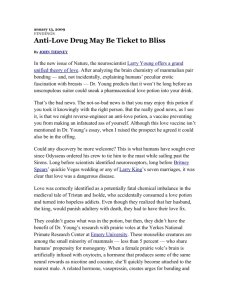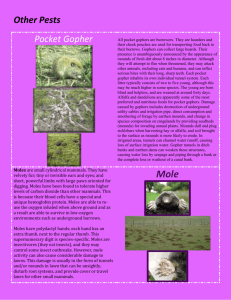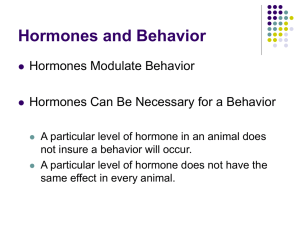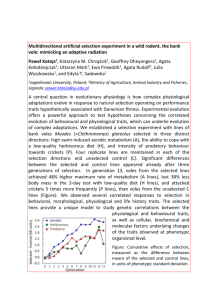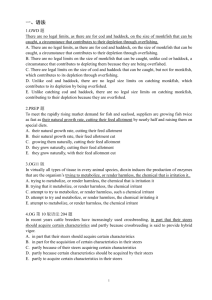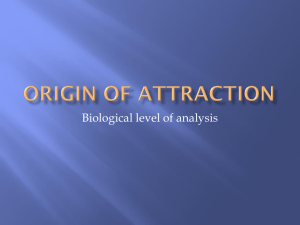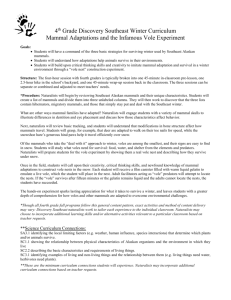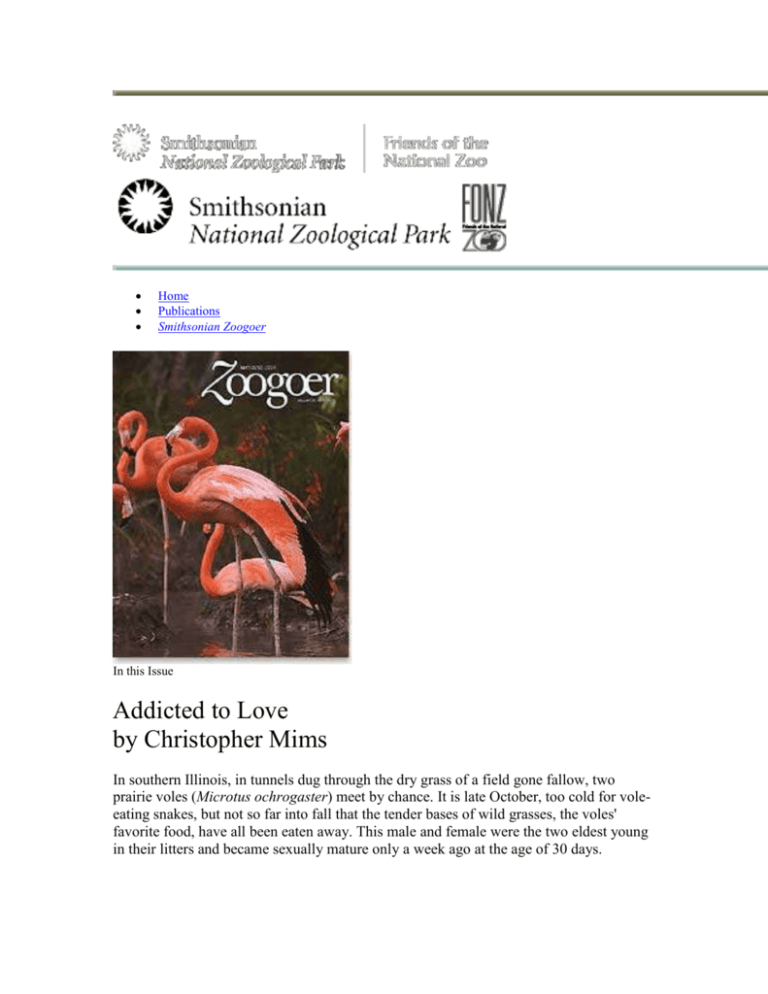
Home
Publications
Smithsonian Zoogoer
In this Issue
Addicted to Love
by Christopher Mims
In southern Illinois, in tunnels dug through the dry grass of a field gone fallow, two
prairie voles (Microtus ochrogaster) meet by chance. It is late October, too cold for voleeating snakes, but not so far into fall that the tender bases of wild grasses, the voles'
favorite food, have all been eaten away. This male and female were the two eldest young
in their litters and became sexually mature only a week ago at the age of 30 days.
Their first meeting is congenial. Unlike most rodents, sexually naïve prairie voles don't
try to attack other, unfamiliar prairie voles: They can't afford to. As members of a species
in which monogamy likely evolved as a way to cope with a hostile environment full of
predators, instinct tells them their chance to find their one mate may be now or never.
More proximately, key areas of their brains contain receptors for a neuropeptide known
as oxytocin, which makes them friendlier or, as scientists put it, "more affiliative," to one
another.
They inhale each other's pheromones, initiating a breathtakingly intricate cascade of
neuronal and hormonal changes in their brains and bodies. Each change in state begets
and is in turn affected by a host of behaviors that include mating, nesting, defending
territory, giving birth, and parental care. The process is so complicated that leading
scientists who study the physiology of monogamy in voles cloak seemingly obvious
conclusions in the preliminary language of hypotheses. Yet, the process is so well
characterized that the essential difference between monogamous prairie voles and their
non-monogamous cousins, montane voles (Microtus montanus), has already been traced
to the smallest unit of biological reductionism: the gene.
Why has so much scientific study been devoted to monogamy in voles? Because it's
possible that what goes on in their genes, brains, and nests resembles what goes on in the
genes, brains, and bedrooms of human beings. "Mammalian species share many
similarities in terms of their physiology, anatomy, and behavior," says Zuoxin Wang,
who studies the changes that mating brings about in the vole nervous system.
"Particularly if you look at dopamine, oxytocin, and vasopressin—it has been
demonstrated that they play an important role in human society; for instance, in love,
social attachment, and reward. So there are great similarities [between voles and
humans]."
The notion that studying voles may provide insights usable to the average Joe is seductive
enough to garner the attention of government grant-making bodies and indirectly rocket
one of the grand old men of vole pair-bonding research, Thomas R. Insel, to the head of
the National Institutes of Mental Health (NIMH).
Larry Young, a former post-doc of Tom Insel who now works at Emory University,
specializes in the molecular and genetic underpinnings of vole pair-bonding and has
already generated insights into the genetic basis of autism in humans. Although Young
cautions that, when comparing human love to vole pair-bonding, "…Many aspects such
as the individual hormones that will be involved [in humans] may be different [from
those in voles]," it's likely that the physiological processes in both species are similar.
Love at First Smell
As creatures that rely as much on smell as humans do on sight, the first thing the voles do
is investigate one another's odor. They sniff each other's genitals and realize they have
encountered an unrelated animal of the opposite sex.
Molecules of the male vole's musk enter a receptor on the roof of the female's mouth,
called the vomeronasal organ, which exists solely to detect socially relevant odors.
(Humans also possess this organ, but it's likely vestigial for us.) The molecules are then
transformed into neural signals that travel to the female's olfactory bulb, or the smellprocessing part of her brain.
Within minutes, hormone levels in both voles' brains begin to change. Their bodies
release nor-epinephrine, also known as nor-adrenaline, a kind of pick-me-up or triple
espresso latte that in humans may contribute to the mania and sleeplessness typical of the
first stages of passionate love.
Soon after the first rush of passion, the voles become visibly relaxed. As they get used to,
or "habituate" to one another, their levels of cortisol, the primary stress hormone, drop as
a direct result of one another's presence. Like chimps grooming or humans embracing,
they are using one another to regulate their respective physiologies.
Contributing to the voles' state of general well-being is the release of another hormone
that sounds like an acne cure but isn't: oxytocin. If the chemistry of social interaction
were an episode of American Idol, oxytocin would be the 10,000-megawatt superstar.
According to Susan Carter, a scientist at the University of Chicago who published the
earliest data on the significance of oxytocin in vole pair-bonding, "Oxytocin is a hormone
associated with emotional safety and security. It down-regulates stress hormones and
encourages positive social behavior. This in turn feeds back and opens the way for more
sociality."
Monogamy and Molecules
While new to pair-bonding, both of these voles have activated some of the same brain
circuits before when in the presence of their littermates. Specifically, many of the
pathways in their brains that involve oxytocin are used every time they encounter another
vole. Zuoxin Wang, another former post-doc of Tom Insel who now has his own lab at
Florida State University, calls these circuits social memory. "If you think of pair-bonding
or social attachment, there are a couple of things this requires. Number one, there must be
a reward system," says Wang. "Number two, there must be a system by which the animal
can recognize a partner from a stranger."
Without oxytocin, there can be no social memory. Genetically engineered mice born
without the gene for oxytocin perform normally on every kind of cognitive or olfactory
task save one: They have complete social amnesia. They can't recognize or remember
anyone.
A female vole with a fully functioning oxytocin system is a happy, reproductively
functional female vole. Males, on the other hand, rely on a second molecule in addition to
oxytocin, a chemical called vasopressin, which is just as versatile as oxytocin. In fact,
400 million years ago, they were the same molecule, present in the ancestor of both
vertebrates and invertebrates. In all the eons since they split, oxytocin and vasopressin
differ from one another by only two amino acids, out of a total of nine. Yet in some ways,
oxytocin and vasopressin couldn't be more at odds—in frogs, birds, hamsters, and voles,
vasopressin is associated with territoriality and aggression. Even snails respond to
injections of vasopressin with a defensive reaction.
Throughout evolutionary history, both vasopressin and oxytocin have had starring roles
in reproduction and the increasingly complicated behaviors surrounding it, including
parenthood and sociality. "You can go all the way back to worms and find an ancestral
peptide that appears to be involved in controlling reproduction—egg-laying behavior, for
instance. As you make your way up to mammals, it's involved not in egg-laying, but
uterine contractions to give birth," says Young.
The Beast with Two Backs
Forty-eight hours after their first encounter, the male's scent has initiated estrus in the
female, the last hurdle between her and fertility. Propelled by a potent hormonal cocktail,
our pair of fumbling teenage voles does something that radically accelerates the massive
reorganization of neurochemical pathways already in progress in their brains. They mate.
For 24 consecutive hours.
By the end, according to a hypothesis first proposed by a pair of Hungarian researchers
named Sarnyai and Kovacs, our voles are as addicted to one another as junkies to smack.
It seems that romantic love is—not analogously but literally—a process of addiction.
"For the people who study drug reward, there is a common belief that animals or humans
did not evolve a system to deal with drug reward," says Wang. "So drugs somehow
hijack a system in the animal's body for its reward mechanism. Another way to say this is
that we have evolved a reward system that is supposed to be used for natural reward, like
sex and food intake. However, if we don't use that system, drugs can somehow use this
system for its own reward."
How did these two young voles transform so swiftly into star-crossed lovers? The circuits
in their brains that are responsible for social recognition and mediated by oxytocin and
vasopressin forged a bridge to that den of vice, a semi-mythical beast at the root of all our
pleasure-seeking—the reward pathway.
Scientists hypothesize that this convoluted circuit in the brain is the nexus of all
rewarding behaviors, including eating, sex, and drugs of abuse. Textbook diagrams of the
reward pathway inevitably resemble a map of Napoleon's defeat at Waterloo, with multihued arrows representing not the combined armies of Britain and Prussia but connections
between areas of the brain. All of them converge on a single smallish nodule of brain
tissue known to science as the nucleus accumbens.
Here in the nucleus accumbens, a brain chemical called dopamine works its magic. It's a
gross oversimplification, but for starters, it's not a bad one: Dopamine is the feel-good
neurotransmitter, flooding the nucleus accumbens during orgasm or any other pleasurable
or "rewarding" activity.
Give a vole a dose of cocaine and dopamine is released in its nucleus accumbens.
Likewise, let a vole mate for 24 hours, and dopamine is released in its nucleus
accumbens. This holds true for every mammal, including humans, in which scientists
have studied dopamine levels.
And now here's the trick, the little smackerel of data upon which this whole story hinges:
Monogamous voles, and every other monogamous mammal scientists have examined,
have nucleus accumbens that are absolutely lousy with oxytocin receptors. The presence
of these receptors means that when oxytocin is released by that 24-hour bout of mating,
the nucleus accumbens can't help but stand up and take notice, neurons ablaze like
fireworks on the Fourth of July.
Non-monogomous voles, on the other hand, don't have any oxytocin receptors in their
nucleus accumbens. They likely find mating pleasurable, because the feel-good molecule
dopamine is dumped all over the feel-good nucleus accumbens. But because they lack the
proper receptors, their nucleus accumbens can't "hear" the wailing klaxon of billions of
little oxytocin molecules flooding their brains. As a result, montane voles don't associate
mating with a specific kind of pleasure with a specific partner. If we could read the
montane vole's thoughts, he or she would be thinking "Gee, sex feels great!" Whereas the
monogamous prairie vole would be thinking, "Gee, sex with this particular partner feels
great!"
In this way, we can imagine that voles, humans, and many other monogamous mammals
come to associate a particular partner with reward. Junkies do it too, except they fixate on
the drug itself, or paraphernalia associated with the drug.
"Romantic love shows all three of the major characteristics of addiction," says Helen
Fisher, seasoned anthropologist and author of Why We Love: The Nature and Chemistry
of Romantic Love. "These characteristics are tolerance, withdrawal, and relapse. With
tolerance, you see the person on Saturday night, you like them well enough, you begin to
fall in love with them. Then you see them Sunday afternoon, and Wednesday night, and
suddenly you find yourself saying something like, 'I crave you, I can't live without you.'
That's addiction…. It's just like cocaine, you have a little of it, you need more.
"Then there's withdrawal, when you don't get your drug. The other person doesn't call
you back, they go away, they like somebody else, you go into real withdrawal—crying,
staring, even stalking, but real depression. That's characteristic of withdrawal from any
kind of drug.
"The third addictive aspect is relapse. Let's say somebody dumps you and you haven't
seen them for eight months, and then you run into them at a party and they're nice to you,
and they say to you 'Well, let's have lunch.' Suddenly you come home and you're soaring
again with feelings of romantic love—you relapsed!"
The story is only slightly different in male prairie voles. In a brain pickled by
testosterone, vasopressin performs a function analogous to oxytocin, in an area of the
brain called the ventral pallidum, which is just next door to the nucleus accumbens and
just as key to reward. Pleasure, coded as dopamine and electrical signals, passes through
the ventral pallidum after visiting the nucleus accumbens. Vasopressin receptors litter the
surface of the ventral pallidum. Like oxytocin receptors on the nucleus accumbens, these
ventral pallidal vasopressin receptors are present in monogamous voles and
conspicuously absent in non-monogamous species.
Caveat Emptor
The head of the NIMH, Thomas R. Insel, asks the seemingly rhetorical question in a
recent review, "Is Attachment an Addictive Disorder?" For most scientists, it's hardly an
open-and-shut case.
For one thing, the data on whether or not the reward system even exists as we currently
conceive of it, as an all-purpose reinforcer for sex, food, and drugs, are muddy at best. As
a result, scientists such as Darryl Neill, a neurobiologist at Emory University and expert
in the rewarding effects of drugs, are scurrying after alternate explanations.
"The model that I think most neuroscientists have favored is one that says there is a
specific system or even certain cells, like dopamine or maybe even the nucleus
accumbens, that constitute a reward system. It's a very handy way if you're designing an
animal, to think that you would have this reward system, and then all you would have to
do is to slap different stimuli onto it.…The main critique I would propose is the question
of whether there is a generalized reward system in the brain, or if there are multiple ones,
each for different behaviors, that presumably evolved at different times."
Playing House
Whatever comes of this sparring, the behaviors neuroscientists have tasked themselves
with explaining are relatively unambiguous. Within days of the voles' wild lovemaking,
the male has built a nest and both animals have gone from dirty-hippy friendly to
conservative-homeowner hostile in their response to strangers in their territory. Both
fiercely guard the nest and surrounding areas. In 21 days, when the pups arrive, both will
participate in parental care.
Such behaviors are the hallmarks of socially monogamous species, be they birds, wild
dogs, or humans. As we have seen, these behaviors correlate, at least in mammals, with
something as straightforward as the distribution of receptors for a pair of related
neuropeptides, oxytocin and vasopressin.
But what governs the distribution of these receptors? There is evidence that experience
can be a factor in within-species individual variation, but no one has yet connected this to
the relative density of receptors in the brain.
We do know what divides the monogamous from the non-monogamous species. Like the
panda's thumb, which is an extension of a single wrist bone, the mechanism behind the
split between monogamous and non-monogamous voles is an example of the economy of
evolutionary change.
DNA is full of repetitive elements, or stretches in which some of the four nucleotides that
code every protein in every organism (abbreviated A, C, T, and G) seem to stutter. Odds
are, the one you harbor on chromosome 4p, for example, looks like this:
CAGCAGCAGCAGCAGCAGCAGCAGCAGCAGCAGCAG
CAGCAGCAGCAGCAGCAGCAGCAGCAGCAGCAGCAG
CAGCAG
These sequences, called microsatellites, are known as "non-coding" DNA because,
effectively, they have no content. They don't tell the cell's transcription machinery to
make a protein. Rather, they tell the transcription machinery what to do with whatever
protein comes next in the sequence of DNA.
In the sentence "Please say 'Peter Piper picked a peck of pickled peppers' five times fast,"
the instructions "five times fast," are a kind of microsatellite. Instead of telling us what to
do ("say 'Peter Piper…'") they modify a previous instruction. They tell us how to carry it
out.
In the genetic code, microsatellites and other regions of repetitive elements tend to be
unstable. That is, the little molecular robots that copy our DNA sometimes make
mistakes when they hit these repeating sequences. In the previous CAG example on
chromosome 4p, the sequence can expand by as many as 70 repeating elements, resulting
in Huntington's disease.
Scientists have found these repetitive expansions all over the genome. When they appear
in front of the region of DNA coding for the serotonin transporter, they correlate with
anxiety; when they appear in front of the dopamine transporter, they correlate with
attention deficit disorder; and when they appear in front of an enzyme called tyrosine
hydroxylase, they correlate with manic depression.
Prairie voles have a long version of a microsatellite that controls where vasopressin
receptors end up in their brains. As a direct result, prairie voles have vasopressin
receptors on their ventral pallidums, which means they can associate a particular partner
with reward. They can become addicted to—or "fall in love with"—that partner.
On the other hand, montane voles have a very short version of the same microsatellite, so
they have no vasopressin receptors on their ventral pallidums. When they mate, dopamine
hits the ventral pallidum, and makes mating feel good. But with no way for their ventral
pallidum to "hear" the vasopressin that is released during mating, they lack a means to
associate that partner with reward. They are, some might say blissfully, free of the
addiction known as romantic love.
Scientists are currently testing whether or not similar microsatellites correlate with more
or less sociality, affiliation, and perhaps even monogamy, in humans.
Love is Just a Four-Letter Word
Back in the nest, our teenage lovers are all grown up. A litter of pups suckles at their
mother's teats. The male crouches next to his family, not for warmth, but for the stresslowering, oxytocin-releasing comfort that physical contact provides.
Two of the five pups, however, aren't his. One day when he was out foraging, a
wandering male, a representative of half of any typical vole population, paid a visit. At
the same time, a few dozen feet away, a widowed female nurses a litter in which three
pups trace their paternity to our otherwise faithful, thoroughly pair-bonded papa vole.
Was it social experience, in other words too much stress and not enough handling by their
mothers, that drove them to infidelity? Or perhaps it was genetic. In the male, at least,
was it a too-short microsatellite in front of the gene for his vasopressin receptor, and
consequently too few vasopressin receptors on his ventral pallidum, that made
monogamy not as rewarding, and therefore not as compelling, as it should have been?
Lowell Getz, the population biologist who first described vole monogamy in the mid
1970s and who is now retired from the University of Illinois, would say none of the
above. What he discovered is that voles, like so many "monogamous" species, are
monogamous only in the sense that they may share a nest with one partner for life.
Says Getz, "Part of it is covering your bets. It looks like [when they pair-bond] they don't
really evaluate the guys, y'know line 'em up and see which one's the best, which one's the
biggest stud or whatever….So if another guy comes along when you're still reproductive,
OK, take him on too because the guy you picked may not be all that good. Same thing
with the males."
To scientists, monogamy really means "social monogamy." Social monogamy means that
an animal prefers to stay with one partner, but may have extra-pair copulations. Of the
three to five percent of all socially monogamous mammals, some vanishingly small
fraction spends a lifetime mating with just one partner.
"The prairie voles aren't truly monogamous in the sense that they mate only with one
partner," says Young. "So in that sense they're actually even more similar to what we
often find in humans, where we have this desire to have a partner, to have this love, but
people will often stray."
Fortunately, voles lack the engorged neocortex required to invent no-fault divorce. This
pair will stay together until death. In the final chapter of their story, changes in the
dopamine receptors in their brains and their newfound territoriality render them
uninterested in finding a new main squeeze while their first one still lives. Weeks hence,
just as their own parents did, they will awaken to find their mature young set off into the
world, seeking partners, and striving to carry out a program vital to survival and
reproduction—love.
—When he's not writing, Christopher Mims examines patterns of neural activity in the
brains of crayfish at the lab of Donald Edwards at Georgia State University.
ZooGoer 33(3) 2004. Copyright 2004 Friends of the National Zoo.
All rights reserved.

